

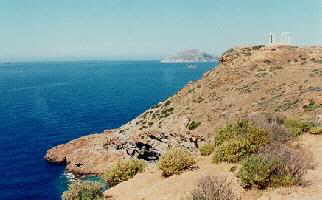 Also known as Cape Colonna, Cape Kolones, Cape Sounion, and Sunium.
At the southernmost tip of Attica, the site is a highly frequented stop on
the bus tour circuit, and that is for a good reason. Sounion is
listed as "the first-choice day trip" from Athens in
Frommer's Budget Travel Guide
. The temple is still stunning and the view is superb. Though
you can no longer walk inside the temple (surprisingly tourists could do
so up until just a few years ago), you can still go anywhere else inside
the sanctuary.
Also known as Cape Colonna, Cape Kolones, Cape Sounion, and Sunium.
At the southernmost tip of Attica, the site is a highly frequented stop on
the bus tour circuit, and that is for a good reason. Sounion is
listed as "the first-choice day trip" from Athens in
Frommer's Budget Travel Guide
. The temple is still stunning and the view is superb. Though
you can no longer walk inside the temple (surprisingly tourists could do
so up until just a few years ago), you can still go anywhere else inside
the sanctuary.
From Athens, it costs a little more to get to Sounion
than to other places around Attica 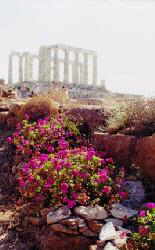 and you have to go to a certain bus station in north-central Athens (the
KTEL buses leave from odos Mavromateon 14, at Areos Park every hour from
6am to 6pm) to catch the bus. I recommend getting there very early,
but the site doesn't open until 9am. You can wait and enjoy the view,
getting a few good pictures before
and you have to go to a certain bus station in north-central Athens (the
KTEL buses leave from odos Mavromateon 14, at Areos Park every hour from
6am to 6pm) to catch the bus. I recommend getting there very early,
but the site doesn't open until 9am. You can wait and enjoy the view,
getting a few good pictures before 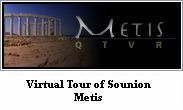 the tourist hordes arrive. Once you get in the site, the slight hassle
was worth it. Pack something to eat and spend a couple hours just sitting
out on the cliffs, looking back at the Saronic Gulf, into the Aegean, and
up at the temple. There is a large tourist pavilion with a restaurant
and a couple of gift shops (rest rooms included), but the prices are expectedly
high. I missed my bus back to Athens (they run fairly often though),
and had to hang around a while, but I thoroughly enjoyed the wait. The
water's edge crashing up against the rocks is quite a sight (
picture
), but you can see the smog looming towards you from Athens on certain days.
Check out the Metis Tour of Sounion with panoramic displays. You will
need the Quicktime plug-in but believe me, if you have not seen these views
yet, you will thank me when you do. And if you have seen them, it sure
can bring back memories.
the tourist hordes arrive. Once you get in the site, the slight hassle
was worth it. Pack something to eat and spend a couple hours just sitting
out on the cliffs, looking back at the Saronic Gulf, into the Aegean, and
up at the temple. There is a large tourist pavilion with a restaurant
and a couple of gift shops (rest rooms included), but the prices are expectedly
high. I missed my bus back to Athens (they run fairly often though),
and had to hang around a while, but I thoroughly enjoyed the wait. The
water's edge crashing up against the rocks is quite a sight (
picture
), but you can see the smog looming towards you from Athens on certain days.
Check out the Metis Tour of Sounion with panoramic displays. You will
need the Quicktime plug-in but believe me, if you have not seen these views
yet, you will thank me when you do. And if you have seen them, it sure
can bring back memories.
For those visitors to Sounion who have a little more time on their hands, there are a few beaches and at least one hotel in the immediate vicinity. The high hill that the temple sits on is almost surrounded by water. There are beaches on both sides of the "isthmus" that connects the temple site to Attica, but the one on the Argo-Saronic Gulf side (West) is somewhat larger and has a few tavernas. The hotels are located here as are a few of the common tourist shops. I have seen the Stefanakis Hotel recommended by tourists in some guide books. It should be a few blocks up from the main street and it is supposedly a nice C-class hotel. The beach here is not sand though, but you can still rent the "water tricycles" and possibly even pedal over to the ancient ship shed site.
The Ancient Site:
Pausanias started off his "Guide to Greece" at Cape Sounion, but he thought 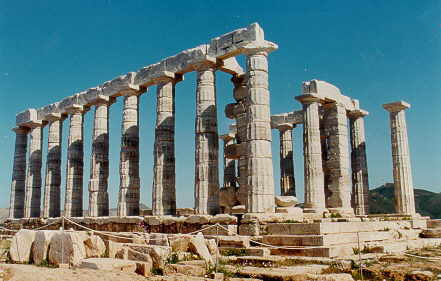 that the main temple was Athena's (
1.1.1
). The Temple of Poseidon is still spectacular today and if you
know where to look on one of the remaining columns, you can even see Lord
Byron's name carved into the stone (it's on one of the square pillars
- the southeast one maybe - right below a joint and not too far up). Unfortunately,
Byron was not the only one to either carve his name or take a piece of the
temple with them. The columns are covered with names; Roman, Turk,
British or by whoever else that passed this way. At one point it was
so bad that sailors were painting their names with black tar on the architrave
blocks above the columnns!
that the main temple was Athena's (
1.1.1
). The Temple of Poseidon is still spectacular today and if you
know where to look on one of the remaining columns, you can even see Lord
Byron's name carved into the stone (it's on one of the square pillars
- the southeast one maybe - right below a joint and not too far up). Unfortunately,
Byron was not the only one to either carve his name or take a piece of the
temple with them. The columns are covered with names; Roman, Turk,
British or by whoever else that passed this way. At one point it was
so bad that sailors were painting their names with black tar on the architrave
blocks above the columnns!
There was an earlier building on the exact same spot,
begun about 490 BC and still unfinished when the Persians ravaged the area
10 years later. The temple that we see today was built ca. 444 B.C.
When it was built there were special features incorporated which helped it
combat its unique location on the water's edge. The columns were cut
with only 16 flutings instead of the usual 20 in order to reduce the corrosion
caused by the constant sea spray. The frieze remains in a badly deteriorated
condition, but it seemed to have depicted a contest of the Lapiths and Centaurs,
the Gigantomachia, and Theseus' deeds. Also in the sanctuary, a small
propylaea can be seen to the right of the modern path through the temenos.
There was also a small stoa (you can still see the column bases) in the NE
corner. The whole sanctuary was protected by large walls. These
were built and the area fortified by the Athenians during the Peloponnesian
War in the 5C B.C. The area was of the utmost importance since grain
ships heading to Athens from the Aegean passed just below the site.
There is another temple in the area which was dedicated to Athena Sounias. It is found on a low hill that tops the isthmus to the N of the Temple of Poseidon. The building had an Ionic colonnade along its E and S sides and was built ca. 450 B.C. There are also remains of a small Doric temple beside it which probably belong to the hero Phrontis. This sanctuary also had a protective temenos wall.
I would like to thank my professor Aileen Ajootian for
her explanations and tour of this site and for the extensive bibliography
below.
Deme Site
Goette, H.R. "Sounion I - III." AM
110 (1995) 171-205.
Whitehead, D. "Some Inscriptions in Attic
Demes," BSA 91 (1996) 341-364.
--, The Demes of Attica 508/7 - 250 B.C. (Princeton 1986). (Buy it
now!)
Young, J.H. "Studies in South Attica, Country
Estates at Sounion," Hesperia 25 (1956) 122-146.
On the Poseidon Sanctuary
Sinn, U. "Sunion," AntW 23.3 (1992)
175-190.
Temple of Poseidon
Dinsmoor, W.B. Jr. Sounion (Athens
1974).
Miles, M.M. "A Reconstruction of the Temple
of Nemesis at Rhamnous," Hesperia 58 (1989) 131-249.
Plommer, H. "Sounion: Another Time Around,"
BSA 71 (1976) 113-116.
Stais, V. ArchEph (1900) 113-115;
(1917) 168-229.
--, To Sounion (Athens 1920).
Tataki, A.B. Sounion: The Temple of Poseidon (Athens 1985). (Buy it now!)
Architectural Sculpture
Delivorrias, A. Attische Giebelskulpturen
und Akrotere des funften Jahrhunderts (Tubingen 1974) 61-73.
Felten, F. and K. Hoeffelener. "Die Relieffreise
des Poseidontempels in Sounion," AM 102 (1987) 169-184.
On the Kouroi at Sounion
Papathanasopoulos, C. Sounion Ieron
(Athens 1983).
Fortifications
Lauter, H. "Das Teichos von Sounion,"
Marburger Winckelmann-Programm (1988) 11-32.
McCredie, J.R. Fortified Military Camps
in Attica (Hesp. Supp. 8 [1966]).
Williams, H. "A Hellenistic Catapult from
Sounion?" EMC 36 (1992) 181-188.
Athena Sanctuary
Corso, A. "Vitruvius and Attic Monuments,"
BSA 92 (1997) 373-400; esp. 383-389.
Dinsmoor, W.B. Jr. Sounion (Athens
1974).
Stais, V. ArchEph (1900) 113-200;
(1917) 168-200.
Alkmaionidai at Sounion
Camp, J. Mck. "Before Democracy: Alkmaionidai and Peisistratidai," in W.D.E.
Coulson, et al eds., The Archaeology of Athens and Attica Under the Democracy
(London 1994) 7-12. (Buy it now!)
Ship sheds
Casson, L. Ships and Seamanship in the Ancient World (Princeton 1971)
363-365. (Buy it now!)
Kenny, E.J.A. "The Ancient Docks on the
Promontory of Sounion," BSA 42 (1947) 78-94.
Morrison, J.S. Greek and Roman Oared Warships (London 1996) 38-39.
(Buy it now!)
Hero Shrine for Phrontis (?)
Abrahamson, H. "A Hero Shrine for Phrontis
at Sounion," CSCA 12 (1979) 1-19.
Picard, C. "L' Heroon de Phrontis au Sounion,"
RA 16 (1940) 5-28.
On roving temples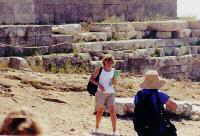
Dinsmoor, W.B. Jr. "Anchoring Two Floating
Temples," Hesperia 51 (1982) 410-452.
--, "The Temple of Ares at Athens,"
Hesperia 9 (1940) 1-52.
--, "The Temple of Poseidon: A Missing
Sima and Other Matters," AJA 78 (1974) 235-238.
Thompson, H.A. "Itinerant Temples of Attica,"
AJA 66 (1962) 200.
On the funerary inscription immured
in the Hellenistic Bastion
Young, J.H. "An Epigram at Sunium," in
FS Robinson v. 2 (St. Louis 1953) 353-357.
On the marble quarries at Agrilieza
Goette, H.R. "Die Steinbruche von Sounion
in Agrileza-Tal," AM 106 (1992) 309-312.
Also see
Langdon, M. "Two Hoplite Runners at Sounion,"
Hesperia 60 (1991) 309-312.
--, "The Tomb of Poston at Sounion,"
Hesperia 54 (1985) 145-148.
Links:
